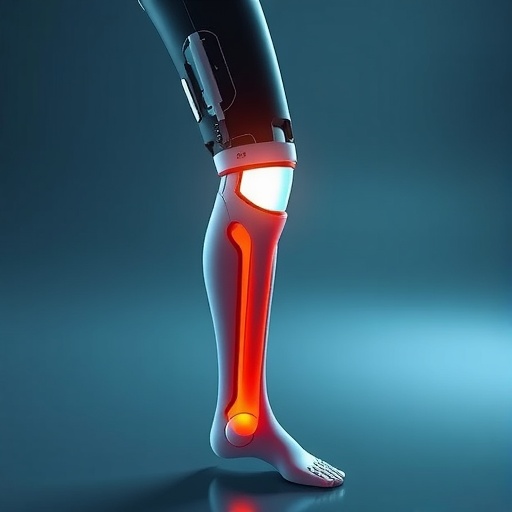A groundbreaking advancement in the field of prosthetics has emerged from the University of Michigan, as roboticists demonstrate the significant benefits of a commercial robotic leg for both high- and low-mobility amputees. This innovative leg, integrating Össur’s Power Knee technology, has revealed its potential to enhance the quality of life for those who rely on prosthetic devices. With primary funding sourced from the National Institutes of Health, this pioneering project is paving the way for a new era in prosthetic mobility and control.
The research team discovered that the powered leg yielded the greatest improvements when they utilized their proprietary control strategy. This advanced approach led to a more symmetrical walking pattern, thereby minimizing risks of tripping and reducing strain on the participants’ sound legs and hips. These findings signify not only a technical advancement but also a paradigm shift in how robotic prosthetics are viewed and utilized within clinical settings.
While there are several robotic leg options available on the market today, their uptake in clinical settings has been slow. Many prosthesis users continue to prefer the simplicity and lightweight nature of passive legs for their daily activities. However, powered prosthetics, such as the one being developed, hold the promise of assisting users in more physically demanding tasks like rising from chairs, navigating stairs, climbing hills, and walking longer distances. This added functionality can help reduce the chance of overuse injuries, thereby encouraging a more active lifestyle among prosthesis users.
Robert Gregg, a professor of robotics and the corresponding author of the study, provided insightful commentary on the significance of the research. He emphasized that previous evidence for the advantages of robotic knees over sophisticated passive designs was minimal, which contributed to the reluctance of insurance companies to cover the costs of robotic prosthetics. This study serves as an essential step towards creating a more compelling case for the adoption of robotic technology within healthcare systems.
Focusing on fundamental activities of daily living, the research involved participants engaging in repetitive tasks such as sitting, standing, and walking. The researchers aimed to showcase the practical benefits of the powered prosthesis in activities where passive knees might fall short. Prosthesis users who required additional support, such as a cane, found that the Power Knee significantly aided them in all tested tasks. Moreover, those with better mobility experienced the most notable improvements in gait when the research team’s control algorithm was employed.
The overarching objective of the team is to make the prosthetic leg mimic the natural function of a healthy human limb. This functionality aims to eliminate compensatory movements that often lead to overuse injuries and unwanted focus on gait deviations. Kevin Best, a research associate and the lead author of the study, remarked on the psychological and physical implications of creating a more lifelike walking experience, reducing both discomfort and social stigma.
Transitioning into the technical aspects of the research, the team explored two distinct control strategies: one developed by Össur, which is rooted in a more conventional recognition of user motion patterns, and the team’s original algorithm, which constantly adapts to the user’s movements. The conventional method delivers reliability and predictability but can lag behind the user’s intent, resulting in potential delays in action. Conversely, Gregg’s team’s control approach relies on real-time analysis and mathematical models of human motion, leading to knee movements that align more closely with the natural biomechanics of walking.
With the evolution of robotic devices, the research highlights immense potential for robotic prostheses within the amputee community and posits that improved user-synchronized control strategies are crucial for the advancement and acceptance of powered prosthetics. Jeff Wensman, a certified prosthetist/orthotist, expressed enthusiasm regarding the possibilities stemming from this research, emphasizing the impact these developments could have on improving the user experience for powered prosthesis recipients.
The study’s results are promising, demonstrating that even participants with long-term use of passive prostheses were able to effectively adapt to the new control mechanisms after only a couple of training sessions. Rather than exhibiting fatigue during the repetitive trials, participants became faster and more agile. Among the more mobile participants, two significant improvements were observed: an increase in heel lift during gait, which can substantially lower trip hazard risks, and a consideration of reduced hip swing, potentially alleviating back pain and extending walking distances for users.
Looking forward, the research team intends to continue examining the safety and effectiveness of their control strategies in more challenging environments, such as negotiating stairs and ramps. They believe that with further practice, participants will achieve greater proficiency, which will only enhance the potential benefits the robotic knee can offer.
Encouragingly, the findings were compelling enough for two participants to switch to using the Power Knee for their everyday needs, marking a definitive move from laboratory research to real-world utility. This transition indicates that innovations in robotic prosthetics are not just theoretical but are indeed making tangible differences in the lives of users.
As the study provides a foundation for further advancements, the team has also applied for patent protection for their innovative control system. The future of prosthetic technology is rapidly evolving, and with it comes hope for enhanced mobility and quality of life for amputees worldwide.
In a world where technology and health are increasingly intertwined, this study stands as a beacon of progress, suggesting that the next generation of prosthetic limbs will not only support but fundamentally transform the way individuals interact with their environments every day.
Subject of Research: Robotic Prosthetic Legs
Article Title: Innovative Robotic Leg Technology Promises Enhanced Mobility for Amputees
News Publication Date: Not specified
Web References: Not specified
References: Not specified
Image Credits: Not specified
Keywords
Robotic prosthetics, powered knees, mobility enhancement, biomechanics, medical technology, user-synchronized control, prosthetic limbs, rehabilitation, overuse injuries, daily living activities.




